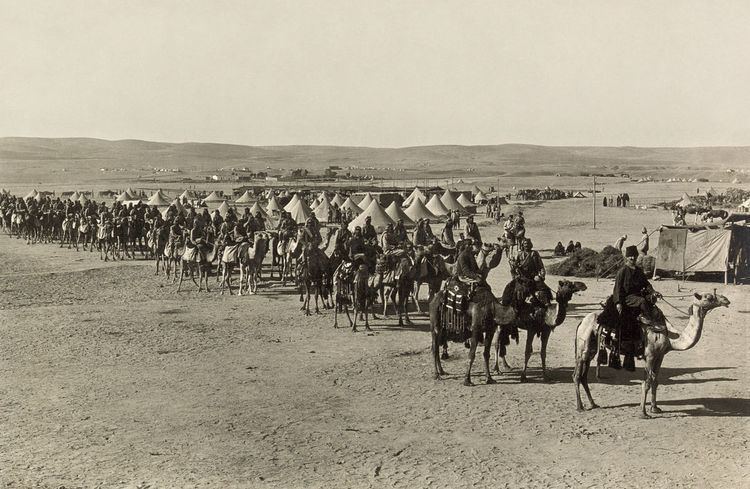 | ||
Camel cavalry, or camelry, is a generic designation for armed forces using camels as a means of transportation. Sometimes warriors or soldiers of this type also fought from camel-back with spears, bows or rifles.
Contents
Camel cavalry were a common element in desert warfare throughout history, due in part to the animal's high level of adaptability. They provided a mobile element better suited to work and survive in an arid and waterless environment than the horses of conventional cavalry. The smell of the camel, according to Herodotus, alarmed and disoriented horses, making camels an effective anti-cavalry weapon when employed by the Achaemenid Persians in the Battle of Thymbra.
Early history
The first recorded use of the camel as a military animal is by the Arab king Gindibu, who is claimed to have employed as many as 1000 camels at the Battle of Qarqar in 853 BC. A later instance occurred in the Battle of Thymbra in 547 BC, fought between Cyrus the Great of Persia and Croesus of Lydia. According to Xenophon, Cyrus' cavalry were outnumbered by as much as six to one. Acting on information from one of his generals that the Lydian horses shied away from camels, Cyrus formed the camels from his baggage train into an ad hoc camel corps with armed riders replacing packs. Although not technically employed as cavalry, the smell and appearance of the camels was crucial in panicking the mounts of the Lydian lancers and turning the battle in Cyrus' favor.
More than sixty years later, the Persian king Xerxes I recruited a large number of Arab mercenaries into his massive army during the Second Persian invasion of Greece, all of whom were equipped with bows and mounted on camels. Herodotus noted that the Arab camelry, including a massive force of Libyan charioteers, numbered as many as twenty thousand men in total strength.
Romans introduced camels in some of their North African military units under the Emperor Hadrian, during the second century. Camel troops or Dromedarii were used during the late Roman Empire.
Muslim conquests
The camel was used in this way by many civilizations, especially in Arabia and North Africa. Both camel and rider were sometimes armored like the contemporary late Roman cataphracts. Extensive use was made of camels during the initial campaigns of Muhammad and his followers. Subsequently the Arabs used camels effectively against their horse-mounted Sassanid and Byzantine enemies during the Muslim conquests.
Modern era
Napoleon employed a camel corps for his French campaign in Egypt and Syria. During the late 19th and much of the 20th centuries, camel troops were used for desert policing and patrol work in the British, French, German, Spanish and Italian colonial armies.
Descendants of such units still form part of the modern Indian, Moroccan and Egyptian armies.
The British-officered Egyptian Camel Corps played a significant role in the 1898 Battle of Omdurman; one of the few occasions during this period when this class of mounted troops took part in substantial numbers in a set-piece battle. The Ottoman Army maintained camel companies as part of its Yemen and Hejaz Corps, both before and during World War I.
The Italians used Dubat camel troops in their Somalia Italiana, mainly for frontier patrol during the 1920s and 1930s. These Dubats participated in the Italian conquest of the Ethiopian Ogaden in 1935-1936 during the Second Italo-Ethiopian War.
Camels are still used by the Jordanian Desert Patrol.
The Bikaner Camel Corps of India's para-military Border Security Force (Central Armed Police Forces) also retain camels.
